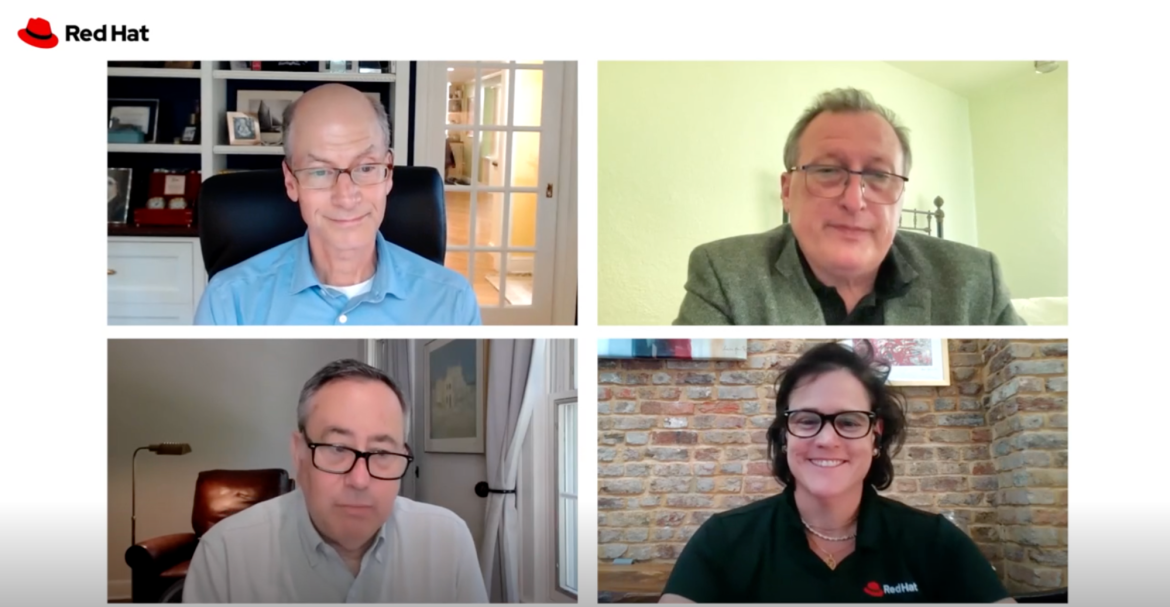Financial services have a long history of leveraging virtual machines (VMs), and like other industries lately, financial services organizations are evaluating strategies for how best to build their cloud infrastructure with VMs and application development. Whether looking for cost savings, improved DevOps capabilities, or scale (more likely all three and others), companies see an opportunity not simply to migrate but to modernize.
To no one's surprise, virtualization was a hot topic at Red Hat Summit this year. Several sessions were dedicated to the topic, and while Red Hat Summit is a technology-first event, the financial services industry was well represented.
Recently, a panel of Red Hat financial services experts discussed the trend. Aric Rosenbaum, Red Hat Chief Technologist, Global FSI, summed up what is driving the virtualization topic this way: “{Financial Institutions} are looking to improve the bottom line, that means being as efficient as possible. You want to drive your marginal transactional cost to zero by simplifying and scaling things appropriately. If you have three teams doing something, when you can have one team doing it, does that make sense?”

Watch the summary video recap of what we heard at Red Hat Summit.
Voices from Red Hat Summit: The three things to consider
Listening to our customers at Red Hat Summit, we heard loud and clear some things that all financial services organizations should consider when building out a VM migration plan.
- Assessment: First, get everyone in the same room. A virtualization plan involves many stakeholders—both internal and external. A thorough evaluation of existing VMs can help avoid unexpected challenges during migration. Identify dependencies, performance requirements and critical workloads early on
- Tracking progress: Starting with a small set of VMs to validate the migration process will allow the project to establish a reporting model to follow. A “single pane of glass” is essential for keeping everyone in sync and can help streamline the process
- Communicate with other teams: One customer from a large US-based bank provided the following example when discussing the importance of open communication: “You need to over-communicate. If you have an application with 20 VMs, the application team may have recently decommissioned these. So why migrate them?”
“Simplicity helps. It helps you with cost-effectiveness, it helps you with operational efficiencies. Why would you waste time doing multiple things if you don't have to.” - Monica Sasso, Global Financial Services Digital Transformation Lead, Red Hat |
Beware of pitfalls (not the old video game - which was awesome)
- Lack of stakeholder alignment: Ensure that all relevant stakeholders, including IT teams, business units, vendors and management, are aligned on the migration strategy and objectives. Misalignment can lead to delays and confusion
- Data integrity and security risks: While starting with common and simpler VMs is a good starting point, VMs with sensitive financial data require additional security measures. Your plan should document procedures and controls to verify compliance
- Resource sizing and scalability: You should attempt to accurately size resources (CPU, memory and storage) for VMs. Scalability is critical for future growth
Migration with an eye toward modernization
Many financial services customers have been on a “modernization journey” for several years. So long, in fact, that the term has probably lost all meaning. With a rapidly changing virtualization market, however, migrating existing VMs is now a priority.
But migration is only the first step. By having a single strategy for how both your VMs and containers will work with your existing cloud infrastructure, you can take advantage of an integrated platform, simplify development processes and ultimately provide a better customer experience.
Red Hat’s Global FS Digital Transformation Lead, Monica Sasso, summed it up nicely when she said, “Simplicity helps. It helps you with cost-effectiveness, it helps you with operational efficiencies. Why would you waste time doing multiple things if you don't have to.”
Red Hat OpenShift Virtualization
Rather than having one strategy for containers and another for VMs, financial services institutions are looking toward a single platform for efficiency and consistency. With a single platform, containers and VMs can run side by side, allowing teams to leverage a single DevOps team, improving both velocity and scale.
Red Hat has worked with financial services companies to migrate VMs from existing estates to Red Hat OpenShift Virtualization. The considerations noted above are the same whether you are migrating hundreds of VMs or hundreds of thousands. Migration to OpenShift Virtualization allows institutions to address their infrastructure’s current need to reduce operating costs and increase IT efficiency while also addressing the modern DevOps requirement to innovate at speed and increase agility.
Key takeaways
- Plan holistically: Get everyone together
- Assessment: Look at all angles
- Communication: Default to over-communicating
Workshops
Red Hat offers half-day workshops to help financial services companies identify, assess and analyze the current virtualization and application landscape across their environments and identify targeted apps and VMs for either migration or modernization efforts. You can register for a workshop in your area or contact us directly for more information about hosting a workshop for your team.
Engage and innovate
If you have any questions or need guidance on how Red Hat can enable your institution to migrate VMs to a modern platform, reach out to us. We’re here to help you navigate this transformative journey and ensure your financial institution remains at the forefront of compliance and innovation.
关于作者
Jeff Picozzi leads a product marketing team, focusing on critical industries and edge services. He joined Red Hat in 2019 and has over 25 years of experience connecting technology products and services to specific business outcomes respective to the financial services, telecommunications, industrial, and retail industries.
产品
工具
试用购买与出售
沟通
关于红帽
我们是世界领先的企业开源解决方案供应商,提供包括 Linux、云、容器和 Kubernetes。我们致力于提供经过安全强化的解决方案,从核心数据中心到网络边缘,让企业能够更轻松地跨平台和环境运营。

